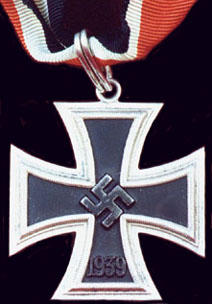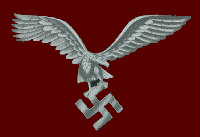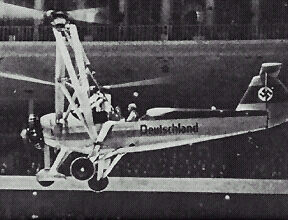|
|
|
 |
 |
Galland's Luftwaffe |
 |
 |
 |
![]()
Diminutive German aviatrix
Became one of Germany's most
remarkable pilots. Her natural flying ability, enthusiasm
and apparent fearlessness made her one of her country's
most respected test |
 |
Hanna Reitsch desplaying the FA-631-V2 D-EKRA
Click Here For Page Two |
| Not yet strictly speaking a test
pilot, Hanna joined a group led by Heini Dittmar
investigating upper air meteorology . This involved her
in long distance and high altitude flights, during the
course of which she established a long-distance gliding
world record for women at over 100 miles. The most
important outcome of that record was undoubtedly her
immediate posting to a "civil" airways training
school at Stettin, one of a number of thinly disguised
military training establishments. At Stettin Hanna
trained on the Focke-Wulf Fw 44 Stieglitz. The course,
which completed. Once again Hanna was the only female at
the school; the pupils, incidentally, wore a uniform
which bore an uncanny similarity to that of the shortly
to be revealed Luftwaffe. With greatly increased experience, Hanna returned to Darmstadt and was allowed to fly the Institute's recently acquired Heinkel He 46c on meteorological flights, many of them at night. The He 46 was no sports aircraft but a military one designed as a Fernaufkliirungsfiugzeug (reconnaissance machine). It was a parasol monoplane powered by a 650 h.p. Bramo nine-cylinder air-cooled radial. It was, by all accounts, a most unpleasant aircraft to fly; it suffered from excessive vibration and had, of course, an open cockpit: hardly ideal for ni ht flights to 10,000ft. The Heinkel used by DFS at Stettin was probably one of six "civilised' He 46cs, with all military equipment and armament removed and with civil registrations that had been issued to the Deutschen Luftsportverband (DLV) for use at flying displays where the foreign press might attend. Goring did not want the existence of the forbidden Luftwaffe to be revealed prematurely. On March 1, 1935, in contravention of international treaty agreements which had never been effectively enforced, the official existence of the Luftwaffe was revealed with 20 squadrons of front-line aircraft. The date became Germany's "Air Force Day" and an intensive open recruiting cam aigu began with thousands of young people eager to join up. The resultant expansion of the Luftwaffe enabled DFS to increase its establishment and, in 1935, Hanna Reitsch was promoted to become a genuine experimental test pilot with the institute. The first aircraft which she was required to test was a new glider then under construction, named the DFS Kranich (Crane). For weeks the newly appointed test pilot haunted the bangin where the glider was taking shape. A1 length it was ready for its maiden flight as is usual on such occasions, a number of the men who had built the machin watched anxiously. The first test fiigh was to begin with an aero-tow. The tug aircraft started its engine and the tow rope was connected and gently pulled taut. A man held up a wingtip, Hanna gave the signal and the tug pilot opened the throttle. The glider began to move, bumping over the grass; the man on the wingtip was running, then let go and fell behind by then the ailerons were biting and, with a gentle backward pressure on the stick, the Crane was airborne for the first time. At 6,500ft Hanna, satisfied that the new glider was stable, cast off and began, on that first of many flights, the long process of discovery needed to establish the aircraft's flight envelope: stalling speed, control harmony, the range of trim, establishment of centre of gravity limits and all the many factors which could affect the handling--including the sort of misuse and overstressing to which she herself had subjected the Grunau Baby in the storm cloud; The test programme of the Kranich went well: certain modifications which Hanna had suggested were accepted and the machine went into production. The next assignment was rather more exciting: the testing of an unusual glider named the Seeadler (Sea Eagle). It had been designed by Hans Jacobs and was, as its name implies, a waterborne lider, claimed to be the first in the world The initial testing was on the Chiemsee, a large lake near Munich, and was not without incident: on the second attempt at a take- off, towed by a powerful motorboat, the entire glider disappeared under water to emerge unscathed. Eventually the was towed off the lake by a Dornier flying boat and Hanna made several sucessful flights. In 1936 Hans Jacobs, the chief designer and director of DFS, had a remit from the Erprobungsstelle der Deutschen Versuchsanstalt fiir Luftfahrt (DLV), the German research organisation for aeronautics. That organisation was becoming concerned at the growing number of fatal accidents occurring to gliders; almost certainly that was due to the greatly increased number of gliders, following the intensive expansion of the Luftwaffe and the drive for air mindedness. Many crashes were caused by pilots exceeding the structural limits of their light woeden gliders, often in similar circumstances to Hanna's cloud flight, and a number had broken up with fatal consequences. DVL were therefore asking for a revision of structural standards. Hans Jacobs knew that making the contemporary gliders stronger would inevitably make them heavier, with a consequently impaired performance. After investigating the official reports of a number of fatal accidents, he came to the conclusion that most of them were caused by the pilots simply exceeding what is now termed Vne the ".never excee speed" for a given aircraft, following disorientation when flying blind in turbulent cloud. He therefore proposed to fit airbrakes which a pilot could deploy to prevent a glider from exceeding its V.ne, even when dived vertically, until the pilot could regain control. That is the story as 'given by Hanna in her autobiography and it might well be true; however, at about the same time, the summer of 1936, the developing Luftwaffe was actively investigating the concept of dive-bombing, realising--unlike the RAF that the most accurate form of bombing is for the pilot to control the flight of the bomb as long as possible, by aiming the aircraft at the target and releasing the bomb at the last possible moment. The future role of the Luftwaffe as a tactical weapon--long range artillery--able to knock out precise targets such as bridges, railway junctions and troop concen- trations just ahead of the advancing army was, in 1936, beginning to crystallise into what was to become the Blitzkrieg--a form of warfare which was to prove devas- tatingly effective in Poland, the Low countries and France four tears later In the summer of 1935 the first prototype of the Junkets Ju 87 dive bomber was test flown from the Junkers factory airfield at Dessau. On a subsequent flight, when the Ju 87 was dived, the tailplane failed and the aircraft crashed. |